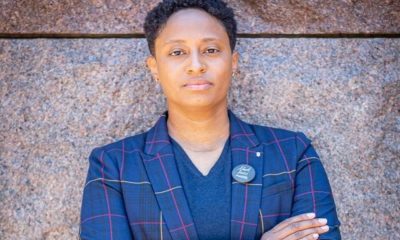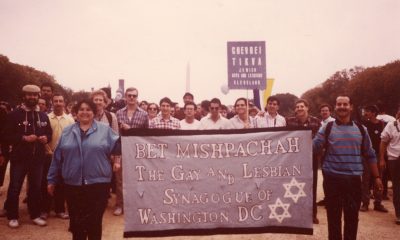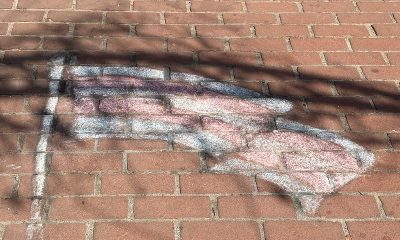a&e features
Letting it all hang out at Pride — did it help us in the long run?
We asked a veteran bike dyke, drag queen, leather daddy and go-go dancer to share their first-hand experiences
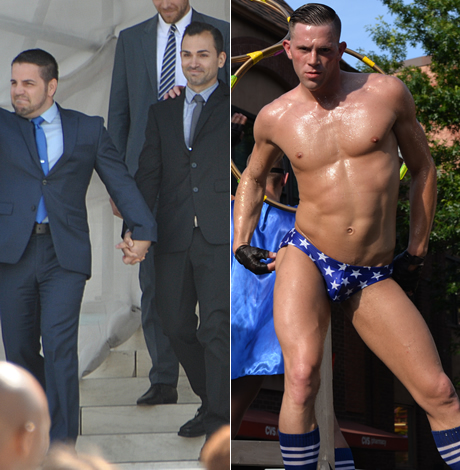
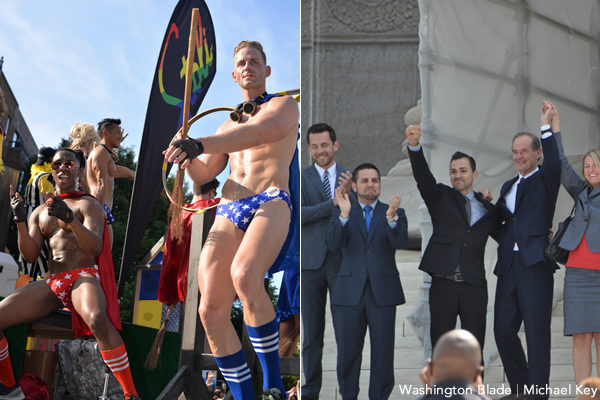
Capital Pride and all Pride events have always been — historically and to this day — a place to let one’s hair down and for LGBT folks to be unabashedly themselves.
Washington, widely seen as a more “buttoned-up” town than, say, New York or Los Angeles, was perhaps not as freewheeling as other cities, especially in the early years of Pride here when it was a one-day block party just off Dupont Circle beginning in 1975, but it’s grown hugely over the decades and for many years we’ve had all the revelers one would expect — scantily clad dancers gyrating around on parade floats, drag queens, leather daddies (sometimes in ass-less chaps), dykes on bikes (some topless) and more.
Conversely, the image the movement presented in the marriage wars and with LGBT people seeking elected office, was much different. Barney Frank and Tammy Baldwin dressed as conservatively as their counterparts on Capitol Hill, there was never anything outré about plaintiffs like Edith Windsor and Jim Obergefell and not-so-surprisingly, current “it” boy wonder, presidential hopeful Pete Buttigieg, is a young, heteronormative-type white gay guy who’s from the Midwest and goes to church.
The dichotomy has always existed as far back as the late Frank Kameny and the late Barbara Gittings demonstrating (pre-Stonewall) at the White House in skirts (for women) and suits (for men) while the gay masses — practically none out pre-’69 — tended to glom on more to the hippies than the Ozzie and Harriets. One of the organizers of the 1993 Gay March on Washington drew criticism from within LGBT circles for wearing leather to the White House to meet Bill Clinton.
But given the mainstream media’s penchant for televising more flamboyant factions in its Pride coverage and political enemies on the right painting Pride gatherings as dens of debauchery, what kind of tension existed between the two extremes? And now 50-some years down the road, did any of it matter? Might we have gotten further faster if we’d somehow reined in our Pride season excesses?
Many folks say either no, it’s a self-hating query or it’s irrelevant.
Or perhaps we needed both?
That’s what Cathy Renna, a long-time PR and media LGBT expert formerly of GLAAD, says.
“We need all of it. Why? Because we are all of it,” Renna says. “Our community is all of it and I think it’s disingenuous to even try to divide people over this. Why are we always trying to divide each other all the time? There are always gonna be folks out there going to Pride because they just want for that one day or one week out of the year, to let their hair down and celebrate, and when I say celebrate, I don’t mean just have a party and get drunk. I mean celebrate our community,
Renna, GLAAD’s national news media director from ’95-’02 and a volunteer for several years prior, says the issue has ramifications in how it plays out among LGBT people and outside that sphere.
As for the latter, Renna says historically it wasn’t so much about the media playing up “debauchery,” so much as it was looking for the most visual, arresting images.
“It was as much about their need to take a photo or shoot video of something different and interesting and highly visual than it was about homophobia or transphobia or wanting to find the more quote-unquote — and please include that because I don’t consider this to be true — but extreme parts of our community. Yes, drag queens and leather people are far more interesting than me and … what we fought for and I think eventually successfully achieved was a diversity of representation without diminishing, demeaning, minimizing or criticizing the parts of our community that are, to use the word of the day, flamboyant.”
Renna says drag queens and leather daddies at Pride deserve respect.

“They were the ones who were brave enough to be themselves and who were raising money for VD clinics before AIDS was even an issue,” she says. “People used to say, ‘But that doesn’t represent me.’ Well guess what — you don’t represent them. We’re a diverse community and this is really about two things — the media’s role and how the media works, which a lot of people don’t understand, and how we within our own community have our own isms — our own internalized homophobia, racism, sexism and transphobia and how it plays out.”
But look at the plaintiffs in the marriage cases and various successful LGBT elected officials, the images they project and it’s not a huge leap to imagine there was some vetting and grooming going on behind the scenes. Sure, those arenas are much different than a Pride event, but even so, one imagines movement gatekeepers would have only been doing their due diligence in monitoring plaintiff or candidate deportment at critical times.
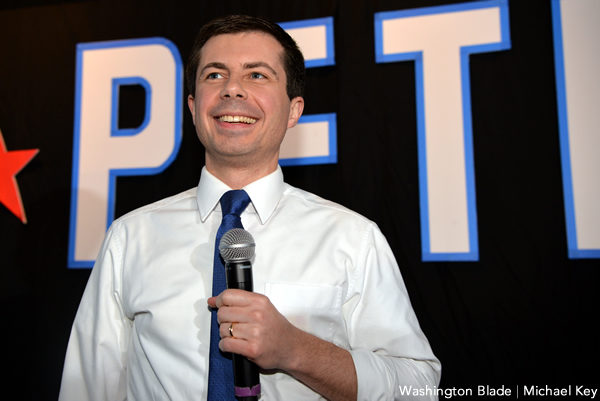
Chuck Wolfe, former president/CEO of the Victory Fund from 2003-2015, says not really.
“I never participated in any conversation like that,” he says. “We had kind of an operating opinion at Victory when I was there that all is fair and it takes every part of our community moving the ball forward and one of the reasons we were successful as fast as we were is because there was no one controlling entity saying, ‘You have to do this,’ or, ‘You can’t do this,’ or, ‘You can’t do that.’ Everybody was doing their part whether it was at a Pride event, testifying on Capitol Hill — all of it mattered, every bit of it.”
Patrick Wojahn, out mayor of College Park, Md., who with his partner Dave Kolesar was one of the couples in the 2006 ACLU/Equality Maryland state marriage case, says it was made clear to him and other plaintiffs to be mindful of their status as representatives.
“One thing we were cognizant of and they made sure we understood was that we were representing the entire LGBT community and we were kind of the face of that,” Wojahn says. “We weren’t supposed to stand in for every single LGBT person out there, but when people saw us, it was understood that how LGBT act, for better or worse, and the political success or failure of what we were doing had a lot to do with how people perceived the LGBT community. It’s true in politics as well. It’s great to have places like Pride where people can act like freaks and do whatever comes upon them to do, but that’s a very different world than say politics where you have to come across as relatable to the people you’re trying to advocate for. It’s best in political situations if you don’t have to overcome that barrier of relatability. If you’re trying to sell people on the idea that we’re entitled to respect, it’s first helpful if they can relate to you on a personal level.”
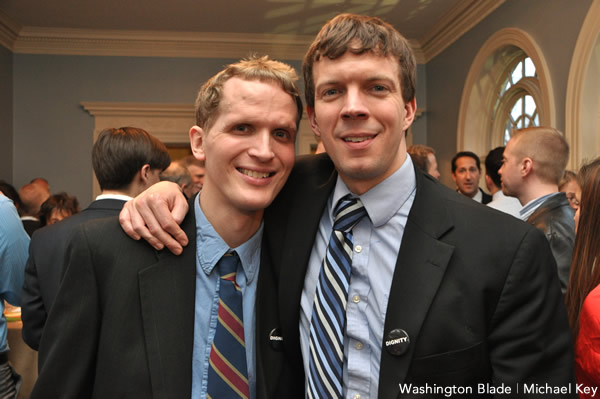
Wojahn says he doubts there was ever much hand-wringing behind the scenes about Pride behavior, but says it’s become less and less of an issue over the years if it ever was one.
“Maybe this is just my skewed perspective of living in the D.C. metro area, but I think there’s been a growing recognition that not all gay people who live next to you are necessarily like the ones out dancing on the floats,” he says. “We’re just as diverse as straight and cisgender people. We have a lot of different things we’re interested in and do a lot of different things. Not all straight people do crazy things. … It’s important to have all different types of people out there being visible.”
Not everyone sees it that way, however. Lloyd Shipley, a longtime 17th Street, N.W. resident, is 70, speaks with a deliciously gravelly voice and prides himself on being a sort of D.C. gay resident curmudgeon type. He’s been attending Capital Pride for 21 years since coming out of straight life (he was married twice to women) and says both Pride and LGBT people in general have gone increasingly downhill over the years.
“This is just my opinion — I believe in opinions and we can have different ones — but I’m so tired of everything being so sexualized in the gay community,” Shipley says. “I feel like Pride has forgotten what Pride is about. You ask nine out of 10 people on Sunday what the theme is this year, they won’t know. But ask them what the best party was, they’ll all know that. I remember my first Pride, I was in Dupont Circle by myself because I didn’t know anybody and I saw float after float and I just cried because they were so meaningful. We should be proud of our accomplishments. Can we knock off the sex shit? Make the floats something to remember. Honor Frank Kameny. Honor Stonewall — not a bunch of guys walking around with their asses hanging out with squirt guns.”
Shipley says it’s not just a Pride problem, but overarching issues he considers rampant among D.C. gays just end up getting writ large there because of the size of the gathering. He says friends in his age bracket are equally fed up.
“I know a lot of older people who say, ‘You know what? I’m done with it. We haven’t been in 15 years.’”
He used to open his home to friends to watch the parade but got tired of ending up with a houseful of 50 people half of whom he says he didn’t know. It took the cake the year he says he found two guys he didn’t know having sex in his bed. This year he’s just inviting a few friends over. They may or may not watch the parade.
“It’s so disorganized,” he says. “It goes on and on, there are huge gaps in the flow, you’ll see float after float after float and none of them reflect the theme whatsoever. It’s gotta mean something. It can’t just be a bunch of half-naked guys throwing beads and squirting people. … I’m gonna write a book someday called ‘Thine Own Worst Enemy.’ We moan and groan about how things are but how much of it is our own damn fault?”
Renna says sensationalizing or using Pride footage as a scare tactic for Middle America may have worked in the short term here and there, but ultimately wasn’t successful.
“I think it did us a favor in that it pushed our visibility,” Renna says. “We pushed through it and it taught us that we need to be better at showing the full diversity of our community. It’s not about don’t show drag queens and leather people, it’s about don’t just show drag queens and leather people.”
Renna says the issue came up constantly in her years of media training. LGBT activists, especially, she says, in smaller markets, lamented the attention the drag queens and go-go boys would get.
“It’s because they’re interesting,” she says. “Be creative, do something interesting. I used to tell GLSEN chapters, rent a school bus, fill it with people, get creative, dress as crossing guards, be fun, be visible. People walking down the street in khakis and T-shirts? Not interesting!”
Wojahn says the whole thing can be touchy.
“If you’re trying to sell people on the idea that we’re entitled to respect, it’s first helpful to relate to them on a personal level,” he says. “You may be taking on a bit more than you can chew when you say, ‘I want you to accept that I’m LGBT, am in a committed relationship and want legal representation with this person, but I also want you to deal with the fact that I’m standing here topless with piercings.”
We asked some early Capital Pride participants for their thoughts.
Ella Fitzgerald, drag queen
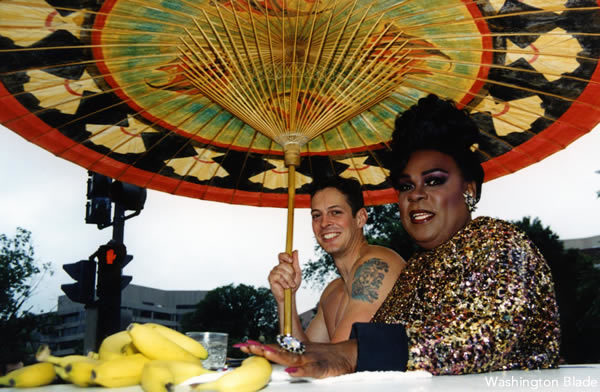
Being a drag queen decade after decade ain’t easy. Just ask Ella Fitzgerald (aka Donnell Robinson), arguably Washington’s most veteran and highly regarded queen.
She remembers her first Capital Pride in 1986 and says it was a much different experience than it is today. Riding with a contingent of Academy of Washington queens in a convertible through Adams Morgan, she remembers being harassed.
“There were straight Latinos giving us the sign language of death signs,” she says. “They harassed the girls on the bikes with their tits out and all that. We’ve definitely come a long way since ’86. It’s much more accepted now. People understand the whole drag thing, the leather community. It’s very diverse now and I remember back in the ‘80s, even in our own community, there was so much discrimination between the drag, the leather and the lesbians. Yes, we still have a long way to go, but we have become much more accommodating of each other’s differences.”
Fitzgerald, 64 and a hairdresser by day, says she was never concerned about being filmed in an early Pride parade or festival. She says she was the first drag queen featured in Washingtonian magazine in 1984 and was happy for the coverage.
She says things have, in her opinion, gotten a bit unnecessarily wild at times over the years.
“The gays who are more flamboyant and make it very obvious, I feel at times that has put a damper on everything we’re trying to achieve,” Fitzgerald says. “How do I say this? There are gays out there on a different level. More class, more sophistication and the younger kids, they’re like wild kids that have been let of a cage and they just act like, ‘I’m gonna do and say whatever I feel at the moment,’ going around in shorts and a T-shirt, ‘cause I want to be seen and I don’t care, this is me and if I want to marry a woman or a man — it’s a lot.”
On the other hand, she doesn’t believe in reining anything in just to be more palatable to straight people.
“Of course not,” she says. “We absolutely need all aspects of the rainbow. I grew up in the ‘70s and it’s amazing to see how far we’ve come in 40-some years. It makes me wonder what the future’s gonna be.”
JOEY DiGUGLIELMO
Margaret McCarthy, Outriders
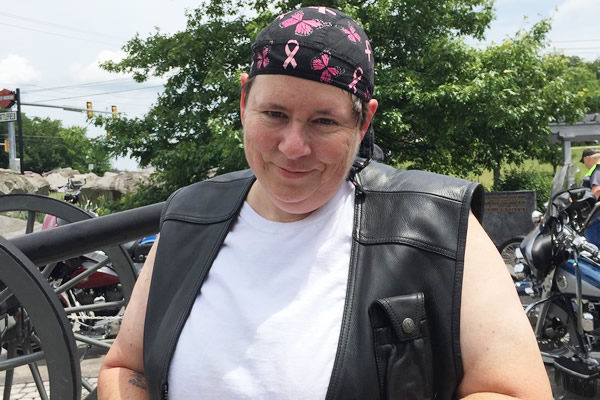
Margaret McCarthy’s Capital Pride experience has evolved over the years.
She came out in the mid-‘80s and has been going to Capital Pride since about ’86 or ’87. She was a member of Open Door Metropolitan Community Church, a sister parish of sorts to MCC-D.C., and participated for years with other parishioners in the Pride parade.
She got into motorcycles around 2009 through a former girlfriend and started riding in Pride with Dykes on Bikes around 2013. A break-off group called Outriders kind of took over a year or so later and eventually McCarthy joined their contingent. They usually have between 40-60 riders each year. Most are members but some join them just for the day.
She agrees with Cathy Renna that a diversity of representation is needed at Pride and in the world in general.
“There are all kinds of people that are part of the gay community — the fairies, the drag queens and all that and that’s part of my community,” says the 54-year-old Montgomery County Police service aide for the 6th District Station in Gaithersburg. “I don’t have to necessarily get it or understand it. I love them and they are part of my community.”
McCarthy says sometimes PDAs get a bit much but it’s not really an LGBT thing.
“I’ve done it. I’ve been walking at Pride and grabbed my girlfriend for a kiss or whatever,” she says. “If you see a couple making out on the Metro or Pride or wherever, I don’t care if they’re gay or straight, I don’t think that’s appropriate. But at a Pride festival, absolutely, it’s about letting go. It’s the one day you can really let your hair down and be totally who you are.”
As for Pride images getting manipulated by political enemies, McCarthy agrees it happens but says LGBT revelers shouldn’t let it dampen their spirits.
“They make it look like it’s all about depravity and sex and stuff and yeah, it makes me mad because that’s not who we are and unfortunately, there are people who may not know gay people and think that’s the whole spectrum. They see that and say, ‘Well look at those faggots and dykes, they’re scum,’ so yeah, it makes me mad. But it’s just one part of our community, it’s not the whole community.”
How has it changed?
McCarthy says she remembers getting harassed at early D.C. Pride events.
“They would see we were with a church and they’d say, ‘How can you be Christian and gay, you’re totally violating the Bible.’ I don’t know if it was Westboro Baptist or who it was, but yeah, there was some of that in the early years.”
McCarthy had protections in writing at her job so she was never worried about being recognized at Pride. She was fully out by her mid-20s.
She says a few Outriders go topless or cover just their nipples.
“I just kind of shake my head and go, ‘Whatever.’ It doesn’t offend me. I don’t really get it — they must get horrible sunburn, but yeah, not many of us do it.”
JOEY DiGUGLIELMO
Kenneth, go-go dancer
Our scantily clad dancer of yore, Kenneth, declined to give his last name. He danced nude at Secrets starting at age 18 from 1996-1999 but is in business now and says he prefers his clients today not know of his past work.
He participated in several Pride parades on the Ziegfeld’s/Secrets float with Ella. The dancers would typically wear matching short shorts and Secrets tank tops.
“I don’t know what the rules are now, I think it’s relaxed a little, but we weren’t ever in thongs or bikinis or things like that,” he says. “We kept it a little more covered back then.”
He was fully out at the time and not fearful of being seen. He says most of the dancers then who were gay were out and not fearful of being seen. A few dancers were straight, he says, but “didn’t seem concerned about” being in a Pride parade.
Now 40, he remembers those years fondly.
“It was a very interesting thing to do when I was 19 or 20. I got to sew my wild oats and it was good experience overall. I learned a lot.”
Kenneth says it’s probably a non-issue today but he suspects more scandalous Pride behavior probably did work against LGBT rights in years past.
“There was a lack of exposure then so if all you saw through the ‘70s to the ‘90s was how they televised it, then you only knew part of the story. I think once there was more exposure, people understood that was only one aspect of the community.”
He says Pride was a much different experience for everyone 20-30 years ago.
“For a lot of people, that was the only time they could be gay,” he says. “They weren’t able to dress and behave the way they wanted to the other 364 days of the year, it was back to their normal attire and behavior, so I would say it’s died down some because we can be ourselves more year round now. If you could only do that during Pride, people tended to go more over the top.”
JOEY DiGUGLIELMO
John Watson, leather enthusiast
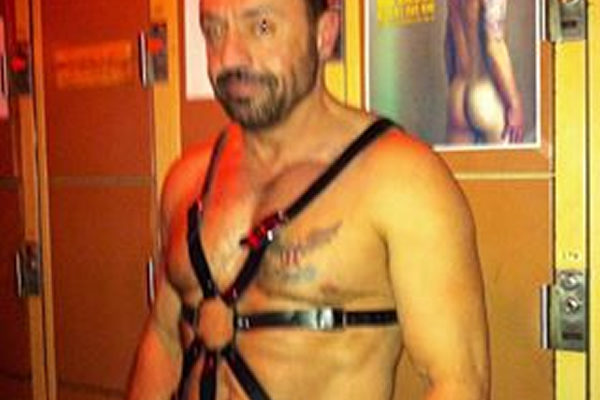
Gay leather enthusiast John Watson says he first got into the D.C. leather scene at age 16 when he and two male friends his age, who lived in Arlington, began going to the D.C. Eagle, the city’s only leather bar, around 1974.
It was a time when the city’s bars and nightclubs, both gay and straight, didn’t consistently require ID checks for young-looking customers, Watson says.
About one year later, in June 1975, shortly after he turned 17, Watson and his two gay friends attended D.C.’s first Gay Pride event, which consisted of a block party on 20th Street, N.W., near Dupont Circle.
Although the three were getting more and more into the leather scene and drove into D.C. nearly every weekend to go to the Eagle, neither of them wore leather at that first Pride block party, Watson says.
“We had on shorts and tank tops, which of course we took off and were shirtless,” he says. “But with the leather scene back then, people didn’t want to appear out in public in it. And thinking back, I don’t remember seeing anybody that first time in leather. There may have been, but I don’t remember seeing anybody in leather.”
It wasn’t until around 1980, Watson thinks, when the D.C. Pride festival had moved from 20th Street to the grounds of Francis School next to P Street Beach Park, that leather enthusiasts began attending Pride wearing leather clothes and gear.
“As it progressed more and more you saw more leather,” he says. “It was when people got to the point where they really weren’t scared, more or less around 1980. People got tired of being in the closet.”
Watson recalls that in the earlier years he and his friends, along with many others in the leather scene, were fearful of the possible repercussions of being publicly identified as leather guys. Being so identified would automatically out you as being gay, he says, as well as out you — even among gays — as being weird or odd.
“It was what you would call an underground community,” he says. “A lot of people felt it was not only strange but perverted, to be honest. If you were into that, you kept your mouth shut most of the time because you didn’t want anyone to know. Even the regular gay people were, ‘Oh, wow, that’s perverted.’ It wasn’t until the 1990s that I began to wear leather in public. Before that I would take it with me and put it on inside the clubs.”
Thankfully, Watson said, attitudes began to change as the LGBT rights movement became more visible and assertive in the 1980s and 1990s. He recalls seeing far more leather folks at D.C. Pride events in those years, possibly even more than what is seen in more recent years as the Pride events have become more “corporatized.”
Watson, who works in insurance, says he managed to keep his interest in leather separate from his work other than times he has worked at the Eagle. Among his most interesting “day work” jobs, he said was a stint from 1983-1988 as an assistant clerk at the U.S. Supreme Court.
Among other things, he gave private tours at the court to gay rights pioneer Frank Kameny and then-Washington Blade News Editor Lisa Keen.
LOU CHIBBARO, Jr.
a&e features
Peppermint thrives in the spotlight
In exclusive interview, she talks Netflix show — and the need to resist Trump’s attacks
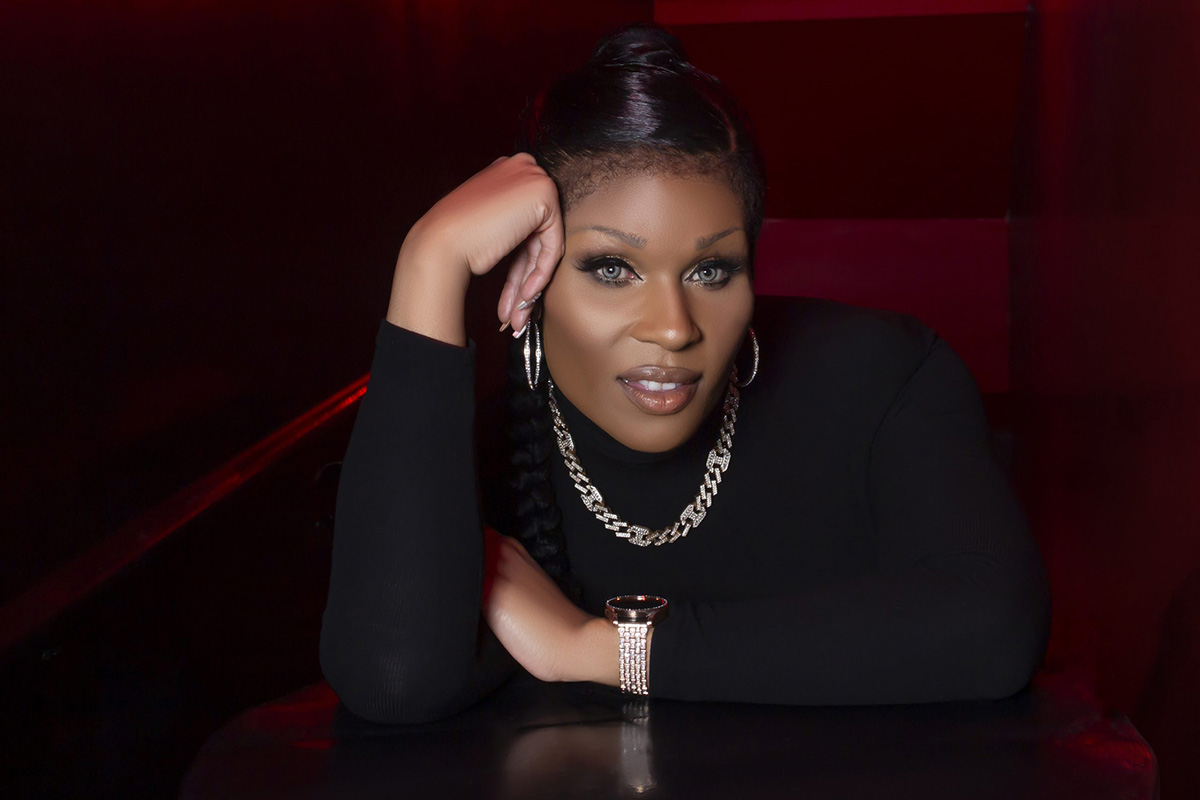
As an entertainer, there’s not much that Peppermint hasn’t done. She’s a singer, actor, songwriter, reality TV personality, drag queen, podcaster and the list goes on. Most importantly, as an activist she has been an invaluable role model for the trans, queer, and Black communities.
She’s a trailblazer who boasts an impressive list of ‘firsts.’ She is the first out trans contestant to be cast on “RuPaul’s Drag Race” (Season 9). She is the first trans woman to originate a principal musical role for Broadway’s “Head Over Heels.” She was also the first trans woman to compete in the runaway hit series “Traitors,” on Peacock, and she is the ACLU’s first-ever Artist Ambassador for Trans Justice. Her accolades are a true testament of the courage it took for Peppermint to live her authentic self.
We caught up with Peppermint to chat about her activism, taking on bigger roles on screen, our current political and social climate and life beyond the lens. For Peppermint, coming out as trans was not just a moment of strength—it was a necessity.
“It unfolded exactly as I had imagined it in terms of just feeling good and secure about who I am. I was in so much pain and sort of misery and anguish because I wasn’t able to live as free as I wanted to and that I knew that other people do when they just wake up. They get dressed, they walk out the door and they live their lives. Being able to live as your authentic self without fear of being persecuted by other people or by the government is essential to being healthy,” Peppermint tells the Blade in an exclusive interview.
“I was not able to imagine any other life. I remember saying to myself, ‘If I can’t imagine a life where I’m out and free and feeling secure and confident and left alone, then I don’t even want to imagine any kind of a life in the future,’” says Peppermint.
Recently, Peppermint returned for season 2 of Netflix’s comedy “Survival of the Thickest.” She added some spice and kick to the first season in her role as a drag bar owner. This time around, her character moves center stage, as her engagement and wedding become a major plot line in the show. Her expanded role and high-profile trans representation come at just the right time.
“It’s the largest acting role I’ve ever had in a television show, which my acting degree thanks me. It feels right on time, in a day where they’re rolling back trans rights and wanting to reduce DEI and make sure that we are limited from encouraging companies, corporations, industries, and institutions from not only featuring us, but supporting us, or even talking about us, or even referencing us.
“It feels great to have something that we can offer up as resistance. You can try to moralize, but it’s tougher to legislate art. So it feels like this is right on time and I’m just really grateful that they gave me a chance and that they gave my character a chance to tell a greater story.
Peppermint’s expanded role also accompanies a boom in queer representation in Black-powered media. Networks like BET and Starz and producers like Tyler Perry, are now regularly showcasing queer Black folks in main story lines. What does Peppermint think is fueling this increased inclusion?
“Queer folks are not new and queer Black folks are not new and Black folks know that. Every Black person knows at least one person who is queer. We are everywhere. We have not always been at the forefront in a lot of storytelling, that’s true, and that’s the part that’s new. It’s Hollywood taking us from the place where they usually have held us Black, queer folks in the makeup room, or as the prostitute, as an extra—not that there’s anything wrong with sex work or playing a background performer. I’ve played the best of the hookers! But those [roles] are very limiting.
“Hollywood has not historically done and still does not do a very good job of, including the voices of the stories that they make money [on]. And I think they’re realizing [the need] to be inclusive of our stories and our experiences, because for a long time it was just our stories without our actual experiences. It’s also exciting. It’s dramatic. It makes money. And they’re seeing that. So I think they’re just dipping their toes in. I think that they’re going to realize that balance means having us there in the room.”
Peppermint’s activism is tireless. She has raised more than six figures for prominent LGBTQ rights groups, she continues to speak around the nation, appears regularly on major media outlets addressing trans and LGBTQ issues and has been honored by GLAAD, World of Wonder, Out magazine, Variety, Condé Nast and more—all while appearing on screen and onstage in a long list of credits.
Now, under the Trump administration, she doesn’t have time to take a breath.
“I wouldn’t be able to do it if it weren’t second nature for me. Of course, there are ups and downs with being involved with any social issue or conversation and politics. But I am, for now, energized by it. It’s not like I’m energized by like, ‘Ooh, I just love this subject!’ right? It’s like, ‘Oh, we’re still being discriminated against, we gotta go and fight.’
“That’s just what it is. I get energy because I feel like we are quite literally fighting for our lives. I know that is hyperbole in some regards, but they are limiting access to things like housing, healthcare, job security and not having identification. Passport regulations are being put in a blender.”
Peppermint also mentions her thoughts on the unfair mandates to remove trans service members and revoke the rights and resources from the veterans who worked their whole lives to fight for this country.
“When you strip all these things away, it makes it really difficult for people to have a life and I know that that is what they’re doing. When I look around and see that that is what is at stake, I certainly feel like I’m fighting for my life. And that’s energizing.
“The only thing that would be the most rewarding besides waking up in a utopia and suddenly we’re all equal and we’re not discriminating against each other—which probably is not happening this year—is to be able to be involved in a project like this, where we can create that world. It’s also being built by people who are a part of that story in real life and care about it in real life.”
Peppermint is clear on her point that now is the time for all of the letters of the LGBTQ community to come together. Everyone who is trans and queer should be joining the fight against the issues that affect us all.
“Just trust us and understand that our experiences are tied together. That is how and why we are discriminated against in the way[s] that we are. The people who discriminate—just like how they can’t really distinguish between somebody who’s Dominican and somebody who’s African American — you’re Black when you’re getting pulled over. We are discriminated against in much the same way. It’s the same with being trans or queer or gender non-conforming or bi, we all have our own experiences and they should be honored.
“When laws are being created to harm us, we need to band together, because none of y’all asses is gonna be able to stop them from getting rid of marriage equality—which is next. If you roll the tape back to three years ago when somebody was trying to ask me about drag queen bans on readings in school, I was saying they’re coming for trans rights, which comes for bodily autonomy and abortion rights, which comes for gay marriage rights. Those three things will be wiped out.
Peppermint doesn’t take a pause to get fired up and call gay folk out in their obligation to return the favor to the Black trans community.
She shares with us her final thoughts.
“You cis-gender homosexuals need to stand the fuck up and understand that we are standing in front of you. It’s very difficult to understand this and know this, but so many of the rights that we have were hard fought and won by protest and by people fighting very hard for them. And many of those people in every single instance from the suffrage movement, obviously Civil Rights, queer rights, the AIDS and HIV movement—Black queer people have been there the entire time. Trans people have always been a part of that story, including Stonewall. Yes, we are using different terminology. Yes, we have different lenses to view things through, but let me tell you, if you allow us to be sacrificed before you see us go off the side, you will realize that your foot is shackled to our left foot. So, you better stand the fuck up!”
Peppermint for president!
a&e features
Tristan Schukraft on keeping queer spaces thriving
New owner of LA’s Abbey expands holdings to Fire Island, Mexico
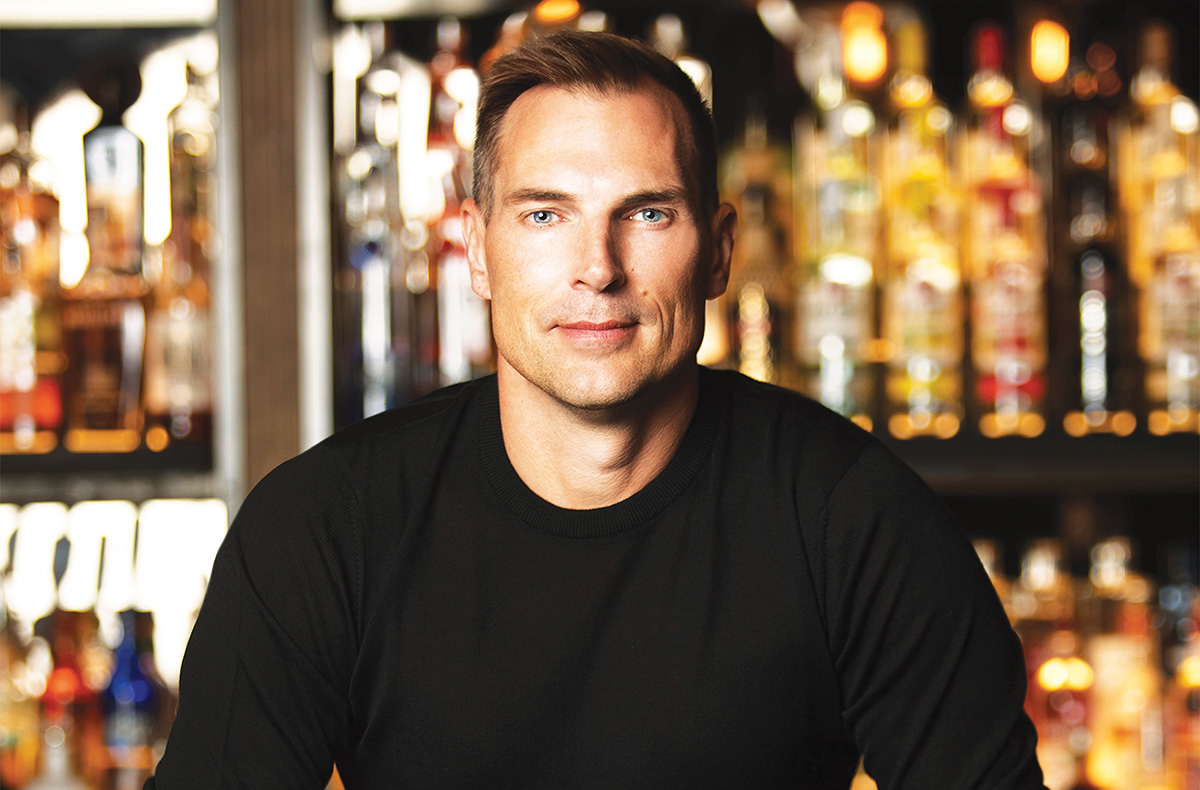
LOS ANGELES — Like the chatter about Willy Wonka and his Chocolate Factory, the West Hollywood community here started to whisper about the man who was going to be taking over the world-famous Abbey, a landmark in Los Angeles’s queer nightlife scene. Rumors were put to rest when it was announced that entrepreneur Tristan Schukraft would be taking over the legacy created by Abbey founder David Cooley. All eyes are on him.
For those of us who were there for the re-opening of The Abbey, when the torch was officially passed, all qualms about the new regime went away as it was clear the club was in good hands and that the spirit behind the Abbey would forge on. Cher, Ricky Martin, Bianca del Rio, Jean Smart, and many other celebrities rubbed shoulders with veteran patrons, and the evening was magical and a throwback to the nightclub atmosphere pre-COVID.
The much-talked-about purchase of the Abbey was just the beginning for Schukraft. It was also announced that this business impresario was set to purchase the commercial district of Fire Island, as well as projects launching in Mexico and Puerto Rico. What was he up to? Tristan sat down with the Blade to chat about it all.
“We’re at a time right now when the last generation of LGBT entrepreneurs and founders are all in their 60s and they’re retiring. And if somebody doesn’t come in and buy these places, we’re going to lose our queer spaces.”
Tristan wasn’t looking for more projects, but he recounts what happened in Puerto Rico. The Atlantic Beach Hotel was the gay destination spot and the place to party on Sundays, facing the gay beach. A new owner came in and made it a straight hotel, effectively taking away a place of fellowship and history for the queer community. Thankfully, the property is gay again, now branded as the Tryst and part of Schukraft’s portfolio with locations in Puerto Vallarta and Fire Island.
“If that happens with the Abbey and West Hollywood, it’s like Bloomingdale’s in a mall. It’s kind of like a domino effect. So that’s really what it is all about for me at this point. It has become a passion project, and I think now more than ever, it’s really important.”
Tristan is fortifying spaces for the queer community at a time when the current administration is trying to silence the LGBTQ+ community. The timing is not lost on him.
“I thought my mission was important before, and in the last couple of months, it’s become even more important. I don’t know why there’s this effort to erase us from public life, but we’ve always been here. We’re going to continue to be here, and it brings even more energy and motivation for me to make sure the spaces that I have now and even additional venues are protected going in the future.”
The gay community is not always welcoming to fresh faces and new ideas. Schukraft’s takeover of the Abbey and Fire Island has not come without criticism. Who is this man, and how dare he create a monopoly? As Schukraft knows, there will always be mean girls ready to talk. In his eyes, if someone can come in and preserve and advance spaces for the queer community, why would we oppose that?
“I think the community should be really appreciative. We, as a community, now, more than ever, should stand together in solidarity and not pick each other apart.”
As far as the Abbey is concerned, Schukraft is excited about the changes to come. Being a perfectionist, he wants everything to be aligned, clean, and streamlined. There will be changes made to the DJ and dance booth, making way for a long list of celebrity pop-ups and performances. But his promise to the community is that it will continue to be the place to be, a place for the community to come together, for at least another 33 years.
“We’re going to build on the Abbey’s rich heritage as not only a place to go at night and party but a place to go in the afternoon and have lunch. That’s what David Cooley did that no others did before, is he brought the gay bar outside, and I love that.”
Even with talk of a possible decline in West Hollywood’s nightlife, Schukraft maintains that though the industry may have its challenges, especially since COVID, the Abbey and nightlife will continue to thrive and grow.
“I’m really encouraged by all the new ownership in [nightlife] because we need another generation to continue on. I’d be more concerned if everybody was still in their sixties and not letting go.”
In his opinion, apps like Grindr have not killed nightlife.
“Sometimes you like to order out, and sometimes you like to go out, and sometimes you like to order in, right? There’s nothing that really replaces that real human interaction, and more importantly, as we know, a lot of times our family is our friends, they’re our adopted family.
Sometimes you meet them online, but you really meet them going out to bars and meeting like-minded people. At the Abbey, every now and then, there’s that person who’s kind of building up that courage to go inside and has no wingman, doesn’t have any gay friends. So it’s really important that these spaces are fun, to eat, drink, and party. But they’re really important for the next generation to find their true identity and their new family.”
There has also been criticism that West Hollywood has become elitist and not accessible to everyone in the community. Schukraft believes otherwise. West Hollywood is a varied part of queer nightlife as a whole.
“West Hollywood used to be the only gay neighborhood, and now you’ve got Silver Lake and you’ve got parts of Downtown, which is really good because L.A., is a huge place. It’s nice to have different neighborhoods, and each offers its own flavor and personality.”
Staunch in his belief in his many projects, he is not afraid to talk about hot topics in the community, especially as they pertain to the Abbey. As anyone who goes to the Abbey on a busy night can attest to, the crowd is very diverse and inclusive. Some in the community have started to complain that gay bars are no longer for the gay community, but are succumbing to our straight visitors.
Schukraft explains: “We’re a victim of our own success. I think it’s great that we don’t need to hide in the dark shadows or in a hole-in-the-wall gay bar. I’m happy about the acceptance. I started Tryst Hotels, which is the first gay hotel. We’re not hetero-friendly, we’re not gay-friendly. We’re a gay hotel and everyone is welcome. I think as long as we don’t change our behavior or the environment in general at the Abbey, and if you want to party with us, the more than merrier.”
Schukraft’s message to the community?
“These are kind of dangerous times, right? The rights that we fought for are being taken away and are being challenged. We’re trying to be erased from public life. There could be mean girls, but we, as a community, need to stick together and unite, and make sure those protections and our identity aren’t erased. And even though you’re having a drink at a gay bar, and it seems insignificant, you’re supporting gay businesses and places for the next generation.”
a&e features
Creator Max Mutchnick on inspirations for ‘Mid-Century Modern’
Real-life friendships and loss inform plot of new Hulu show
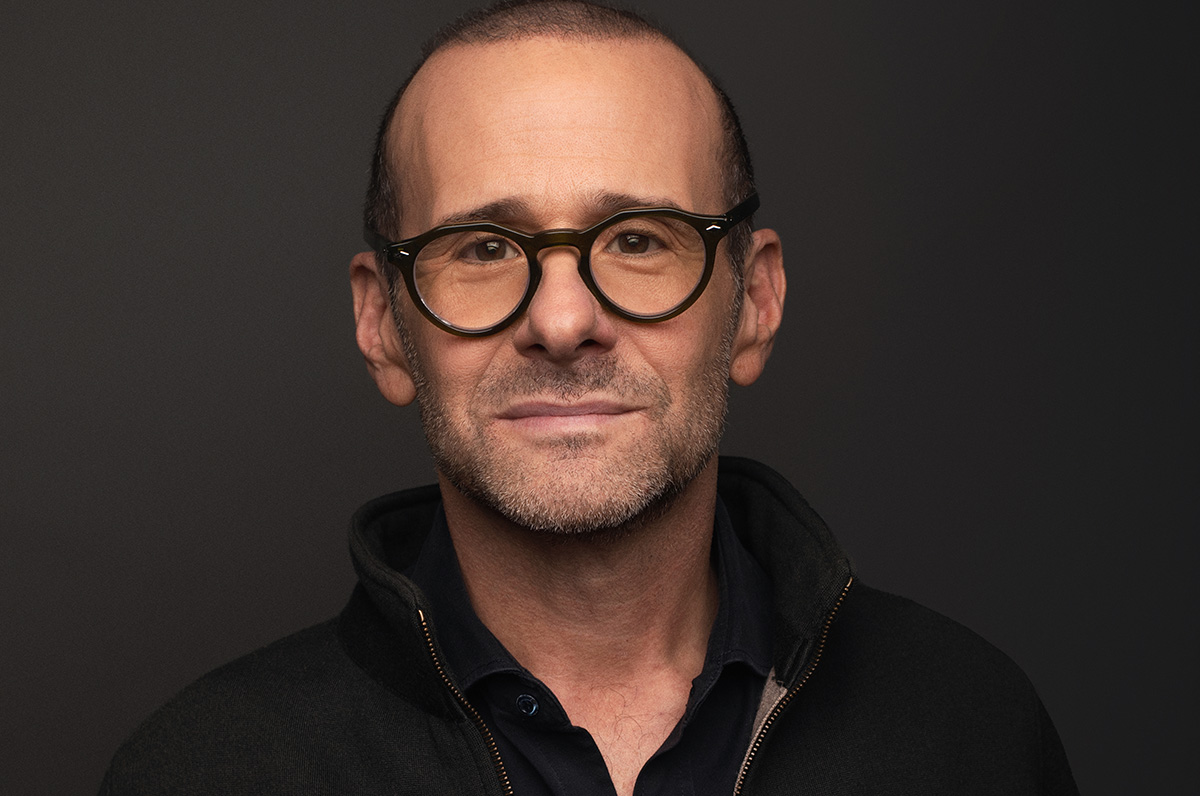
It’s been a long time – maybe 25 years when “Will & Grace” debuted – since there’s been so much excitement about a new, queer sitcom premiering. “Mid-Century Modern,” which debuted on Hulu last week, is the creation of Max Mutchnick and David Kohan, the gay men who were also behind “Will & Grace.”
Set in Palm Springs, Calif., following the death of the one of their closest friends, three gay men gather to mourn. Swept up in the emotions of the moment, Bunny (Nathan Lane) suggests that Atlanta-based flight attendant Jerry (Matt Bomer) and New York-based fashion editor Arthur (Nathan Lee Graham) move into the mid-century modern home he shares with his mother Sybil (the late Linda Lavin). Over the course of the first season’s 10 episodes, hilarity ensues. That is, except for the episode in which they address Sybil’s passing. The three male leads are all fabulous, and the ensemble cast, including Pamela Adlon as Bunny’s sister Mindy, and the stellar line-up of guest stars, such as Jesse Tyler Ferguson, Vanessa Bayer, Richard Kind, and Cheri Oteri, keep humor buzzing. Shortly before the premiere of “Mid-Century Modern,” Mutchnick made time for an interview with the Blade.
BLADE: I’d like to begin by saying it’s always a delight to speak to a fellow Emerson College alum. In ways would you say that Emerson impacted your professional and creative life?
MAX MUTCHNICK: I think Emerson was the first place that reflected back to me that my voice, my thoughts were good, and they were worth listening to. I developed a confidence at Emerson that did not exist in my body and soul. It was a collection of a lot of things that took place in Boston, but I mean we can just put it all under the Emerson umbrella.
BLADE: Before “Will & Grace,” you co-created the NBC sitcom “Boston Common,” which starred fellow Emerson alum Anthony Clark. Is it important for you to maintain those kinds of alumni relationships?
MUTCHNICK: Because Emersonians are such scrappy little monkeys and they end up being everywhere in the world, you can’t help but work with someone from Emerson at some point in your career. I’m certainly more inclined to engage with someone from Emerson once I learn that they went to my alma mater. For me, it has much more to do with history and loyalty. I don’t think of myself as one of those guys that says, “Loyalty means a lot to me. I’m someone that really leans into history.” It’s just what my life and career turned out to be. The longer I worked with people and the more often I worked with them, the safer that I felt, which means that I was more creative and that’s the name of the game. I’ve got to be as comfortable as possible so I can be as creative as possible. If that means that a person from Emerson is in the room, so be it. (Costume designer) Lori Eskowitz would be the Emerson version. And then (writer and actor) Dan Bucatinsky would be another version. When I’m around them for a long time, that’s when the best stuff comes.
BLADE: Relationships are important. On that subject, your new Hulu sitcom “Mid-Century Modern” is about the longstanding friendship among three friends, Bunny (Nathan Lane), Jerry (Matt Bomer), and Arthur (Nathan Lee Graham). Do you have a friendship like the one shared by these three men?
MUTCHNICK: I’m absolutely engaged in a real version of what we’re projecting on the show. I have that in my life. I cannot say that I’m Jerry in any way, but the one thing that we do have in common is that in my group, I’m the young one. But I think that that’s very common in these families that we create. There’s usually a young one. Our culture is built on learning from our elders. I didn’t have a father growing up, so maybe that made me that much more inclined to seek out older, wiser, funnier, meaner friends. I mean the reason why you’re looking at a mouthful of straight, white teeth is because one of those old bitches sat across from me about 25 years ago at a diner and said, “Girl, your teeth are a disaster, and you need to get that fixed immediately.” What did I know? I was just a kid from Chicago with two nickels in my pocket. But I found three nickels and I went and had new teeth put in my head. But that came from one of my dearest in the group.
BLADE: Do you think that calling “Mid-Century Modern” a gay “Golden Girls” is a fair description?
MUTCHNICK: No. I think the gay “Golden Girls” was really just used as a tool to pitch the show quickly. We have an expression in town, which is “give me the elevator pitch,” because nobody has an attention span. The fastest way you can tell someone what David (Kohan) and I wanted to write, was to say, “It’s gay Golden Girls.” When you say that to somebody, then they say, “OK, sit down now, tell me more.” We did that and then we started to dive into the show and realized pretty quickly that it’s not the gay “Golden Girls.” No disrespect to the “Golden Girls.” It’s a masterpiece.
BLADE: “Mid-Century Modern” is set in Palm Springs. I’m based in Fort Lauderdale, a few blocks south of Wilton Manors, and I was wondering if that gay enclave was ever in consideration for the setting, or was it always going to be in Palm Springs?
MUTCHNICK: You just asked a really incredible question! Because, during COVID, Matt Bomer and I used to walk, because we live close by. We had a little walking group of a few gay gentlemen. On one of those walks, Matt proposed a comedy set in Wilton Manors. He said it would be great to title the show “Wilton Manors.” I will tell you that in the building blocks of what got us to “Mid-Century Modern,” Wilton Manors, and that suggestion from Matt Bomer on our COVID walks, was part of it.
BLADE: Is Sybil, played by the late Linda Lavin, modeled after a mother you know?
MUTCHNICK: Rhea Kohan (mother of David and Jenji). When we met with Linda for the first time over Zoom, when she was abroad, David and I explained to her that this was all based on Rhea Kohan. In fact, some of the lines that she (Sybil) speaks in the pilot are the words that Jenji Kohan spoke about her mother in her eulogy at the funeral because it really summed up what the character was all about. Yes, it’s very much based on someone.
BLADE: The Donny Osmond jokes in the second episode of “Mid-Century Modern” reminded me of the Barry Manilow “fanilows” on “Will & Grace.” Do you know if Donny is aware that he’s featured in the show?
MUTCHNICK: I don’t. To tell you the truth, the “fanilow” episode was written when I was not on the show. I was on a forced hiatus, thanks to Jeff Zucker. That was a show that I was not part of. We don’t really work that way. The Donny Osmond thing came more from Matt’s character being a Mormon, and also one of the writers. It’s very important to mention that the writing room at “Mid-Century Modern,” is (made up of) wonderful and diverse and colorful incredible humans – one of them is an old, white, Irish guy named Don Roos who’s brilliant…
BLADE: …he’s Dan Bucatinsky’s husband.
MUTCHNICK: Right! Dan is also part of the writing room. But I believe it was Don who had a thing for Donny, and that’s where it comes from. I don’t know if Donny has any awareness. The only thing I care about when we turn in an episode like that is I just want to hear from legal that we’re approved.
BLADE: “Mid-Century Modern” also includes opportunities for the singers in the cast. Linda Lavin sang the Jerome Kern/Ira Gershwin tune “Long Ago (And Far Away)” and Nathan Lane and the guys sang “He Had It Coming” from “Chicago.” Was it important to give them the chance to exercise those muscles?
MUTCHNICK: I don’t think it was. I think it really is just the managers’ choice. David Kohan and I like that kind of stuff, so we write that kind of stuff. But by no means was there an edict to write that. We know what our cast is capable of, and we will absolutely exploit that if we’re lucky enough to have a second season. I have a funky relationship with the song “Long Ago (And Far Away).” It doesn’t float my boat, but everybody else loved it. We run a meritocracy, and the best idea will out. That’s how that song ended up being in the show. I far prefer the recording of Linda singing “I’ll Be Seeing You” over her montage in episode eight, “Here’s To You, Mrs. Schneiderman.” We were just lucky that Linda had recorded that. That recording was something that she had done and sent to somebody during COVID because she was held up in her apartment. That’s what motivated her to make that video and send it. That’s how we were able to use that audio.
BLADE: Being on a streaming service like Hulu allows for characters to say things they might not get away with on network TV, including a foreskin joke, as well as Sybil’s propensity for cursing.
MUTCHNICK: And the third line in the show is about him looking like a “reluctant bottom.” I don’t think that’s something you’re going to see on ABC anytime soon. David and I liked the opportunity to open up the language of this show because it might possibly open the door to bringing people…I’m going to mix metaphors…into the tent that have never been there before. A generation that writes off a sitcom because that language and that type of comedy isn’t the way that they sound. One of the gifts of doing this show on Hulu is that we get to write dialogue that sounds a little bit more like you and I sound. As always, we don’t want to do anything just to do it.
BLADE: It didn’t feel that way.
MUTCHNICK: It’s there when it’s right. [Laughs] I want to have a shirt made with Linda’s line, as her mother always used to say, “Time is a cunt.”
BLADE: “Mid-Century Modern” also utilizes a lot of Jewish humor. How important is it for you to include that at this time when there is a measurable rise in anti-Semitism?
MUTCHNICK: I think it’s important, but I don’t think it’s the reason why we did it. We tried very hard to not write from a place of teaching or preaching. We really are just writing about the stuff that makes us laugh. One of the things that makes something better and something that you can invest in is if it’s more specific. We’re creating a character whose name is Bunny Schneiderman and his mother’s name is Sybil and they made their money in a family-run business, it gets Jewy, and we’re not going to shy away from it. But we’re definitely not going to address what’s going on in the world. That doesn’t mean I don’t find it very upsetting, but I’m writing always from the point of view of entertaining the largest number of people that I can every week.
BLADE: “Mid-Century Modern” has a fantastic roster of guest stars including Jesse Tyler Ferguson, Vanessa Bayer, Billie Lourd, Cheri Oteri, Richard Kind, Rhea Perlman, and Judd Hirsch. Are there plans to continue that in future seasons?
MUTCHNICK: Yes. As I keep saying, if we’re so lucky that we get to continue, I don’t want to do “The Love Boat.” Those are fine comic actors, so I don’t think it feels like that. But if we get to keep going, what I want to do is broaden the world because that gives us more to write about. I want to start to introduce characters that are auxiliary to the individuals. I want to start to meet Arthur’s family, so we can return to people. I want to introduce other neighbors, and different types of gay men because we come in so many different flavors. I think that we should do that only because I’m sure it’s what your life is and it’s what my life is. I’ve got a lot of different types. So, yes, we will be doing more.
BLADE: Finally, Linda Lavin passed away in December 2024, and in a later episode, the subject of her character Sybil’s passing is handled sensitively, including the humorous parts.
MUTCHNICK: We knew we had a tall order. We suffered an incredible loss in the middle of making this comedy. One of the reasons why I think this show works is because we are surrounded by a lot of really talented people. Jim Burrows and Ryan Murphy, to name two. Ryan played a very big role in telling us that it was important that we address this, that we address it immediately. That we show the world and the show goes on. That wasn’t my instinct because I was so inside the grief of losing a friend, because she really was. It wasn’t like one of those showbizzy-type relationships. And this is who she was, by the way, to everybody at the show. It was the way that we decided to go. Let’s write this now. Let’s not put this at the end of the season. Let’s not satellite her in. Let’s not “Darren Stevens” the character, which is something we would never do. The other thing that Jim Burrows made very clear to us was the import of the comedy. You have to write something that starts exactly in the place that these shows start. A set comedy piece that takes place in the kitchen. Because for David and me, as writers, we said we just want to tell the truth. That’s what we want to do with this episode and that’s the way that this will probably go best for us. The way that we’ve dealt with grief in our lives is with humor. That is the way that we framed writing this episode. We wanted it to be a chapter from our lives, and how we experience this loss and how we recover and move on.
-
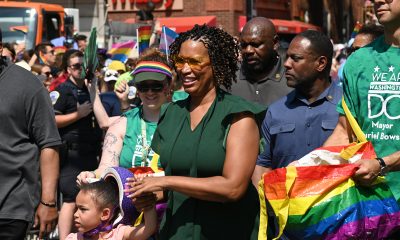
 District of Columbia5 days ago
District of Columbia5 days agoFinal push to raise funds, fill D.C. hotels as WorldPride nears
-

 El Salvador3 days ago
El Salvador3 days agoGay Venezuelan makeup artist remains in El Salvador mega prison
-

 District of Columbia4 days ago
District of Columbia4 days agoReenactment of 1965 gay rights protest at White House set for April 17
-
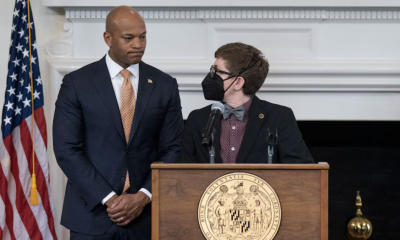
 Maryland4 days ago
Maryland4 days agoFreeState Justice: Transgender activist ‘hijacked’ Moore’s Transgender Day of Visibility event

